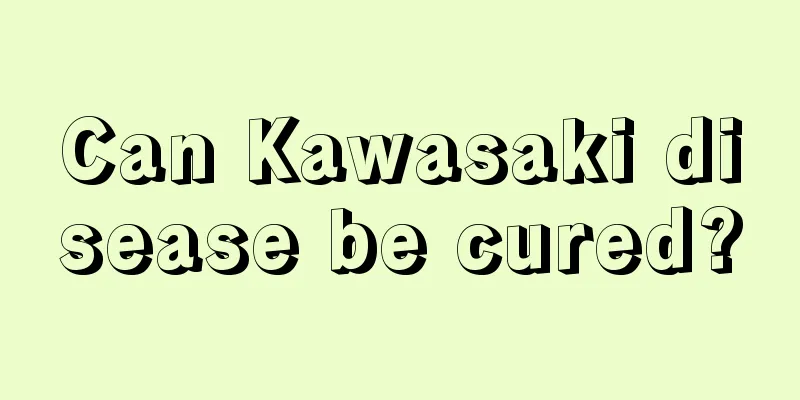Can Kawasaki disease be cured?

|
When a baby suffers from Kawasaki disease, there are usually many signs. If parents understand Kawasaki disease, they can take their children for treatment as soon as possible. The earlier the Kawasaki disease is treated, the easier it is to recover. Although Kawasaki disease is not particularly common, it is not an incurable disease. Usually, active treatment can allow the baby to recover his health. However, it is very important to seek medical treatment in time for Kawasaki disease. Can Kawasaki disease be cured? Although Kawasaki disease can be cured, the treatment process is not easy. Children with mild illness generally have a good prognosis and can gradually recover. However, for children with complications, treatment is long and cumbersome, and there have been cases of sudden death during the recovery period. Parents should be mentally prepared and persist in treatment with their children. How is Kawasaki disease treated? Acute treatment methods 1. Injection of immunoglobulin + oral aspirin Early intravenous immunoglobulin plus oral aspirin treatment can reduce the incidence of coronary artery aneurysms in Kawasaki disease. It is important to emphasize that medication should be taken within 10 days of onset. The dosage is daily intravenous drip of immunoglobulin 400 mg/kg, infused over 2 to 4 hours, for 4 consecutive days; at the same time, oral aspirin 50 to 100 mg/kg.d, divided into 1 to 4 times, for 4 consecutive days, and then increased to 5 mg/kg.d, taken all at once. 2. Oral aspirin Oral aspirin can control acute inflammatory processes and reduce coronary artery lesions, but no controlled studies have shown that aspirin treatment can reduce the incidence of coronary artery aneurysms. The dosage is 30 to 100 mg/kg per day, divided into 4 times. Take it for 14 days, and after the fever subsides, reduce to 5 mg/kg per day, taken once. 3. Corticosteroid treatment It has always been believed that adrenal cortical hormones have a strong anti-inflammatory effect and can relieve symptoms. However, it was later discovered that corticosteroids are prone to thrombosis, hinder the repair of coronary artery lesions, and promote aneurysm formation. Therefore, it is not appropriate to use corticosteroids such as prednisone alone for treatment. Unless there are complications of severe myocarditis or persistent high fever in severe cases, prednisone and aspirin can be used in combination for treatment. Corticosteroids alone are generally not used to control the early inflammatory response of Kawasaki disease. 【Convalescence Treatment】 1. Anticoagulant therapy For cases in the recovery stage, take aspirin 5 mg/kg once a day until the erythrocyte sedimentation rate and platelet count return to normal. If there is no coronary artery abnormality, the drug is generally stopped 6 to 8 weeks after onset. Echocardiograms were performed again 6 months and 1 year later. Patients with residual chronic coronary artery disease need to take anticoagulants for a long time and be closely followed up. Patients with small single coronary artery aneurysms should take aspirin 3 to 5 mg/kg per day for a long time until the aneurysm disappears. For those who are intolerant to aspirin, diphenhydramine can be used at a dose of 6 mg/kg per day, divided into 3 doses. Coronary angiography should be performed annually if echocardiography, clinical data, or exercise testing suggest myocardial ischemia. Patients with multiple or large coronary artery aneurysms should take oral angiography for a long time. Patients with multiple or large coronary artery aneurysms should take aspirin and dipyridamole orally for a long time. Patients with giant tumors are prone to thrombosis, coronary artery stenosis or occlusion, and can use oral warfarin anticoagulants. These patients should limit their activities, not participate in sports, and have their heart condition checked every 3 to 6 months. If there are signs of myocardial ischemia or a positive exercise test, coronary angiography should be performed to understand the progression of the stenosis. Patients with occlusion of one or more major coronary arteries should receive long-term anticoagulant therapy, repeated heart examinations, including myocardial scanning, exercise testing, coronary angiography, etc., and consideration of surgical treatment. 2. Thrombolytic therapy For patients with myocardial infarction and thrombosis, intravenous or percutaneous intracoronary puncture is used to administer the drug to promote coronary artery reopening and myocardial reperfusion. Intravenous thrombolysis: infuse urokinase 20000u/kg within 1 hour, followed by 3000-4000u/kg per hour. Infuse urokinase 1000u/kg within 1 hour of coronary artery administration. Streptokinase can also be used. 10,000 u/kg of streptokinase should be injected intravenously within 1 hour for thrombolysis, and it can be used again after half an hour. The above drugs can dissolve fibrin quickly, have good effects and no adverse reactions. |
>>: Primary school students breast bulge
Recommend
What should I do if my child has a sore throat?
In life, we often encounter sore throats. There a...
Eight-month-old baby sweats on the back of his head
After the baby is eight months old, his body has ...
Is laryngitis serious in children?
In our lives, many children suffer from pharyngit...
Can a five-month-old baby eat rice cereal?
The growth process of every baby is very long. Fr...
What to do about eczema in children
Eczema is a very common disease. This type of dis...
Eight dangerous situations that may damage your baby's eyesight
Case 1: Does excessive eye mucus affect the visio...
What should babies eat if they lack trace elements?
The health of the human body is inseparable from ...
Can children use cooling oil?
Cooling oil is used to treat skin redness, swelli...
What should I do if my baby has a fever?
Many babies are the apple of their parents’ eyes....
Which kind of antipyretic patch is good for children
The pediatric fever-reducing patch is a new type ...
Symptoms of Yin deficiency in babies
With the increase of social pressure, many people...
Does mugwort have any effect on babies?
When mugwort grows, it looks like a straight pole...
Five ways to keep your baby away from prickly heat in summer
Tip 1: Temperature control A hot and humid enviro...
What to do if your child is allergic to medicine and it itches
Children's physical health is very important,...
What causes dark circles under girls' eyes?
Generally speaking, lesbians will not have dark c...









